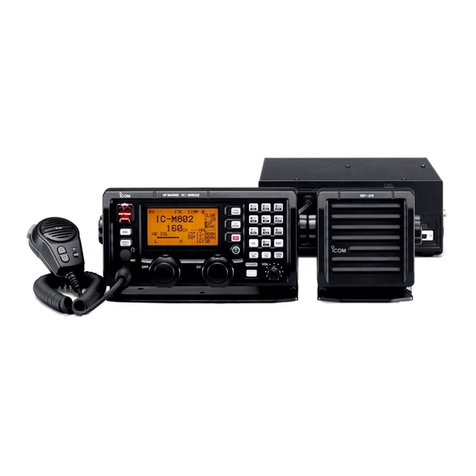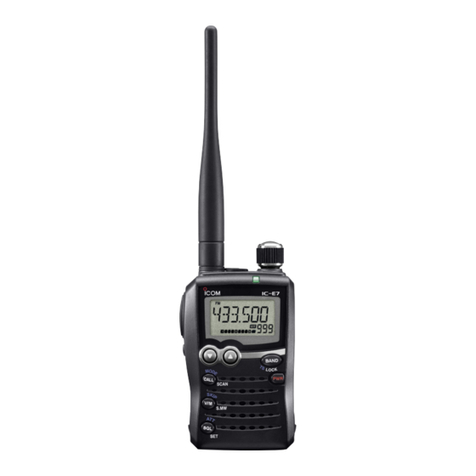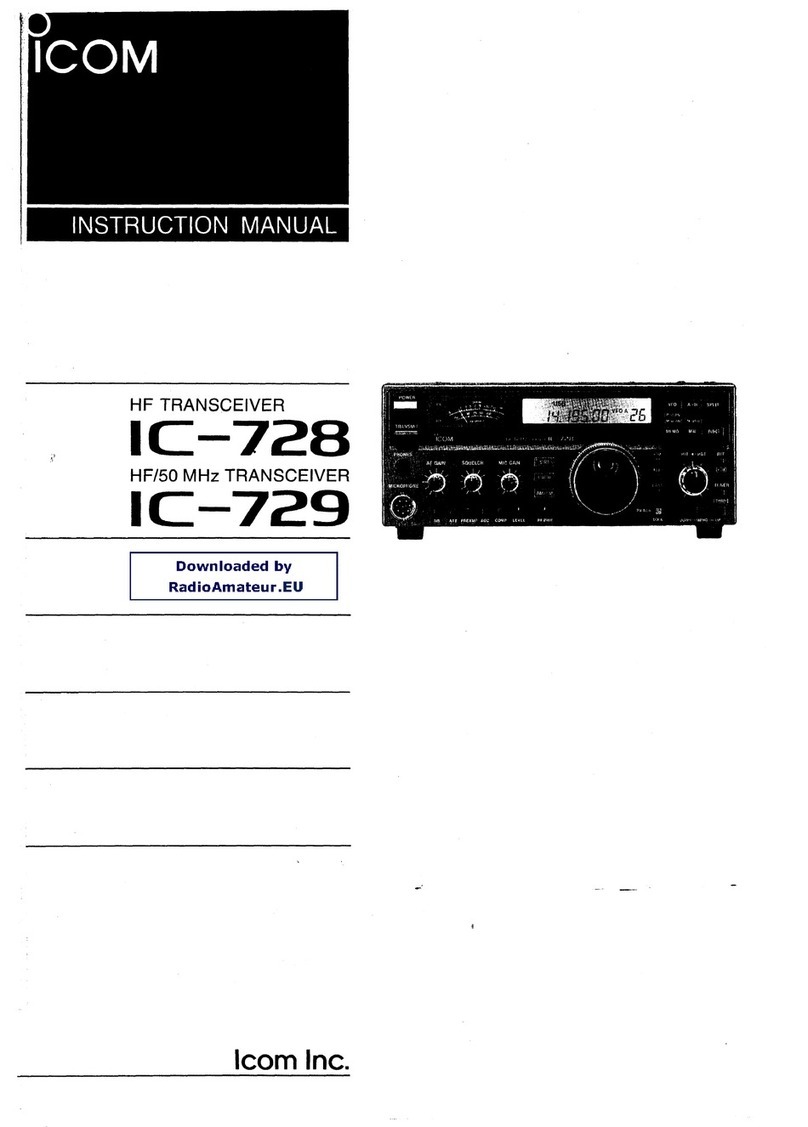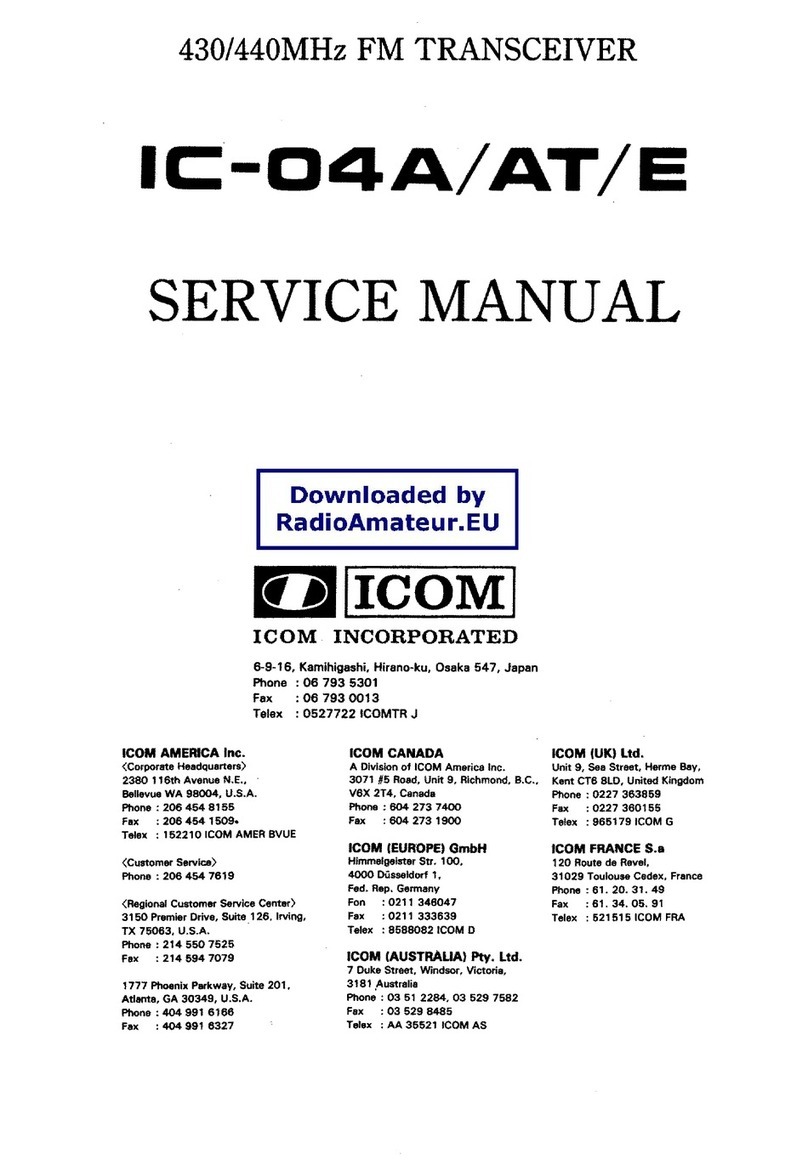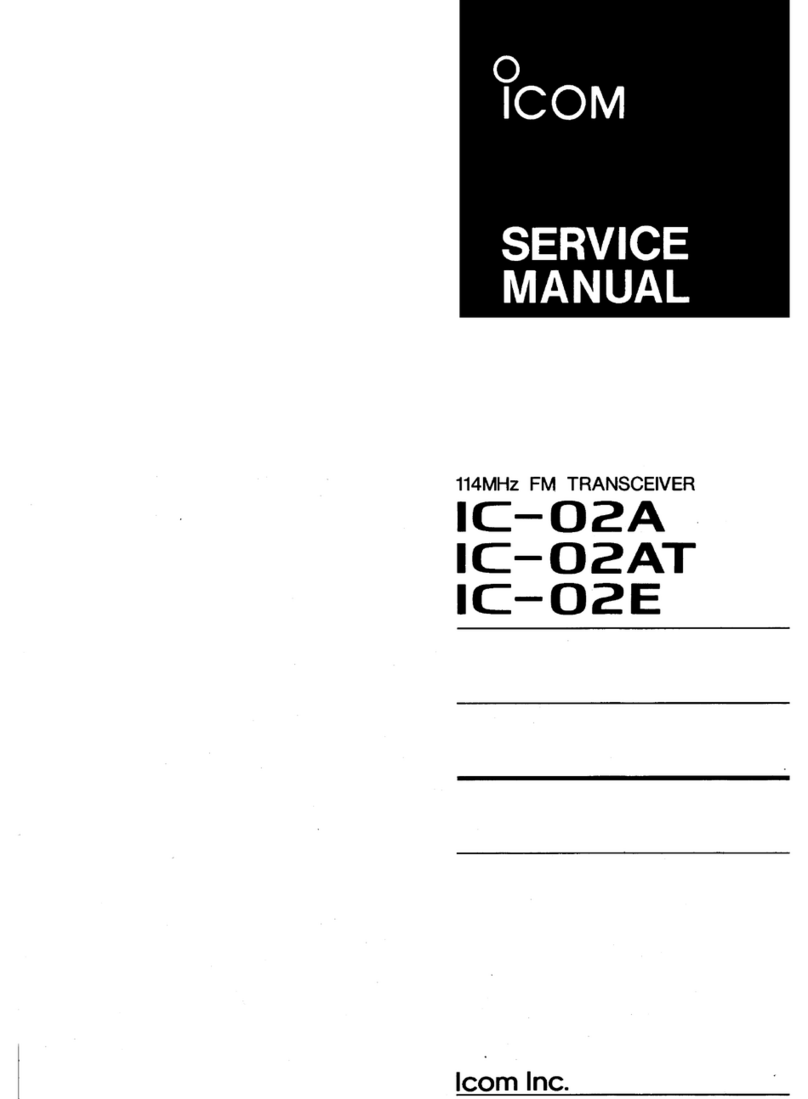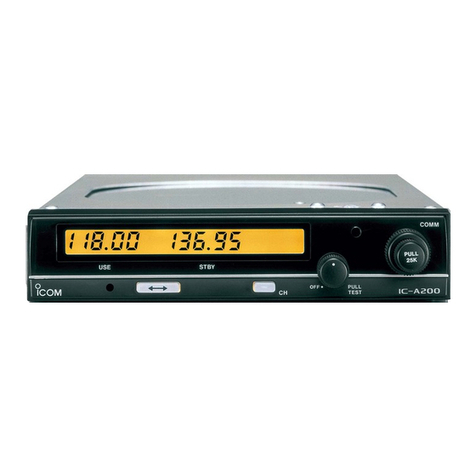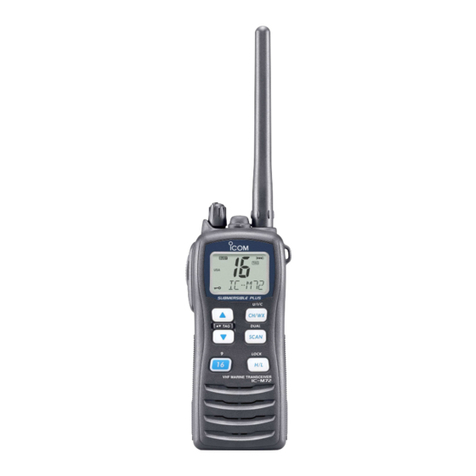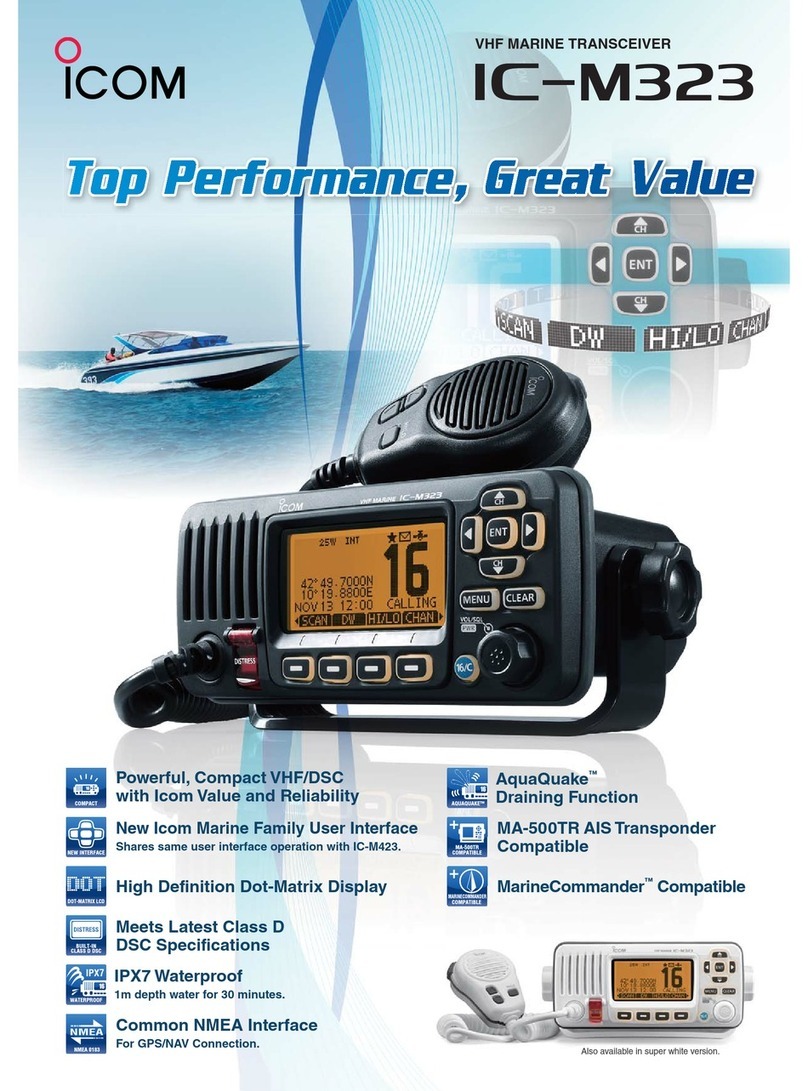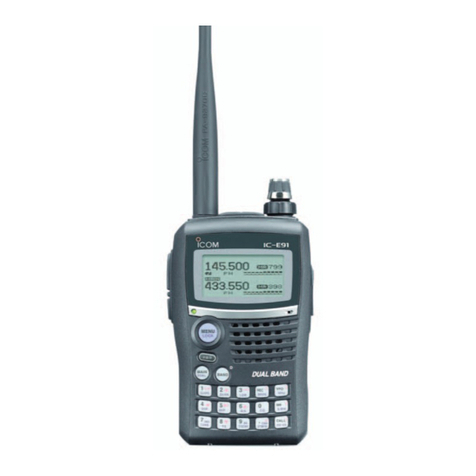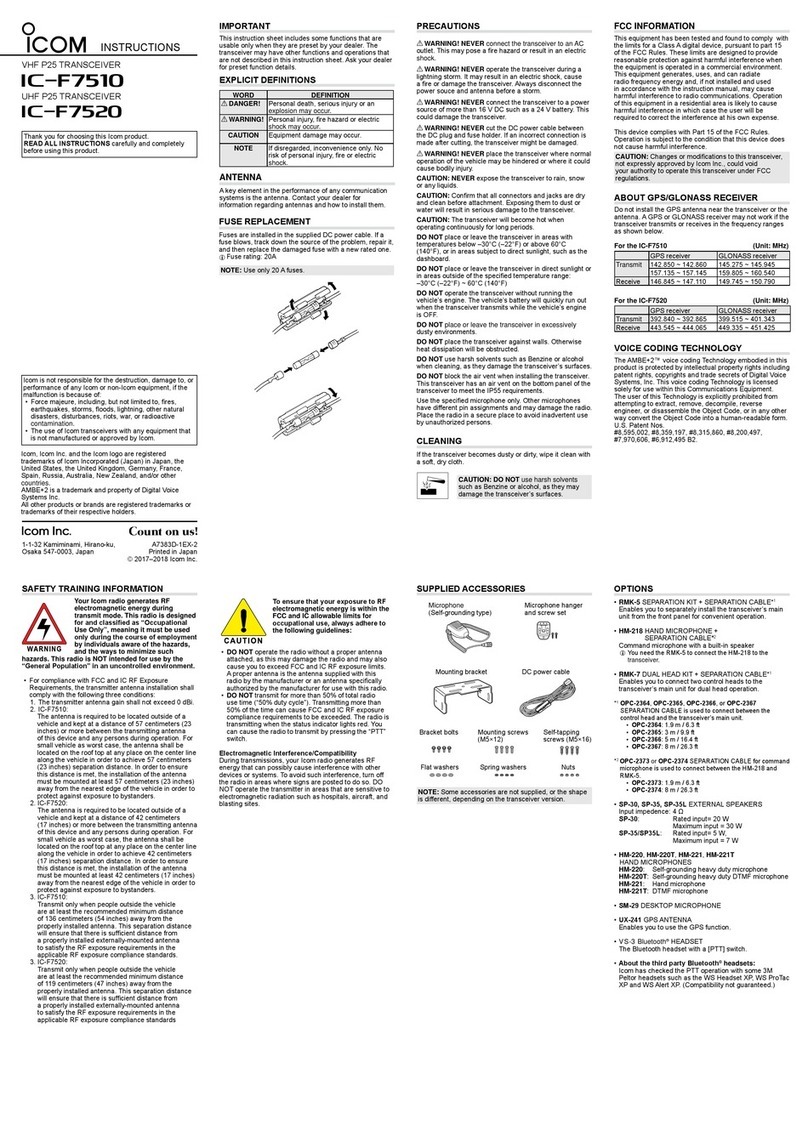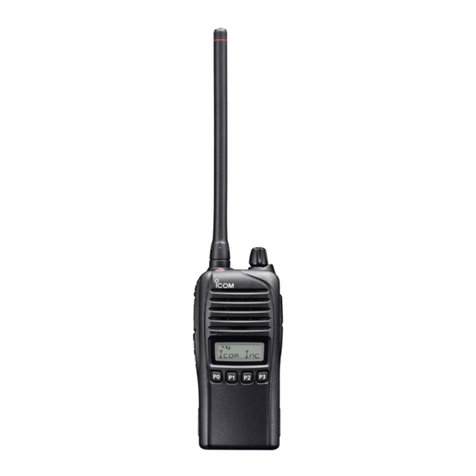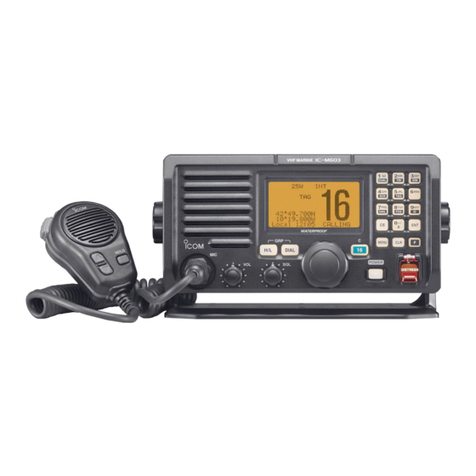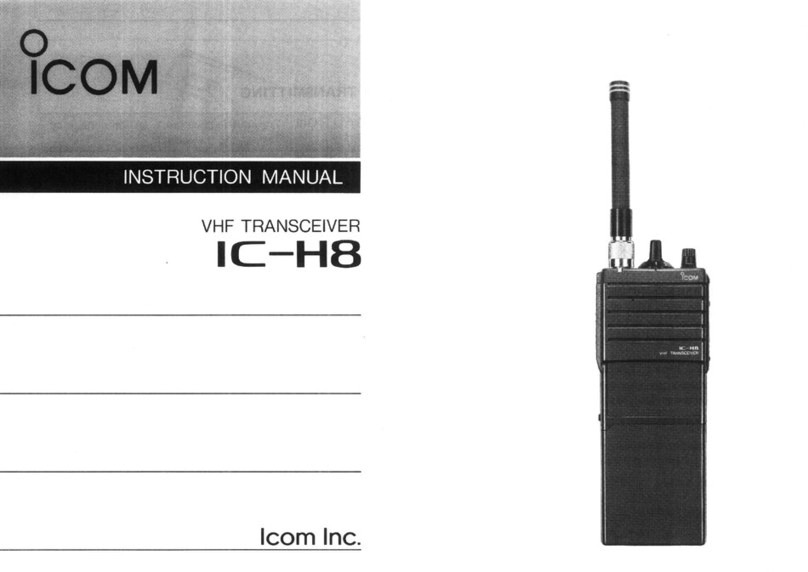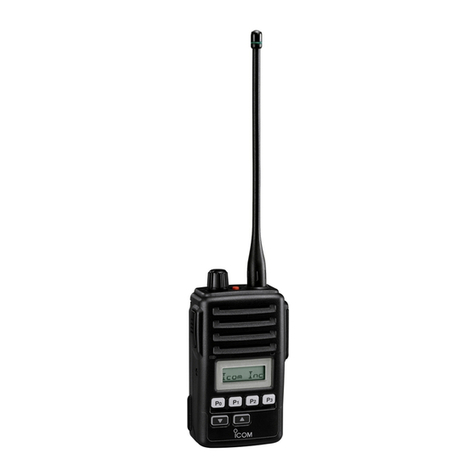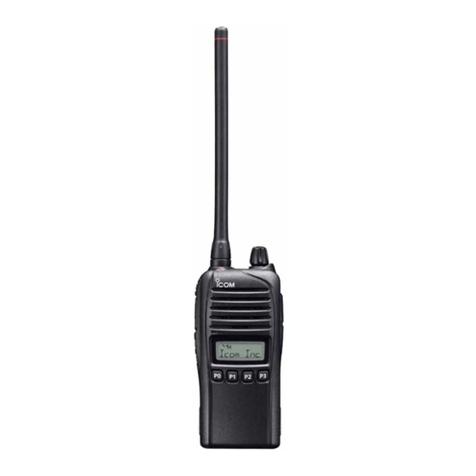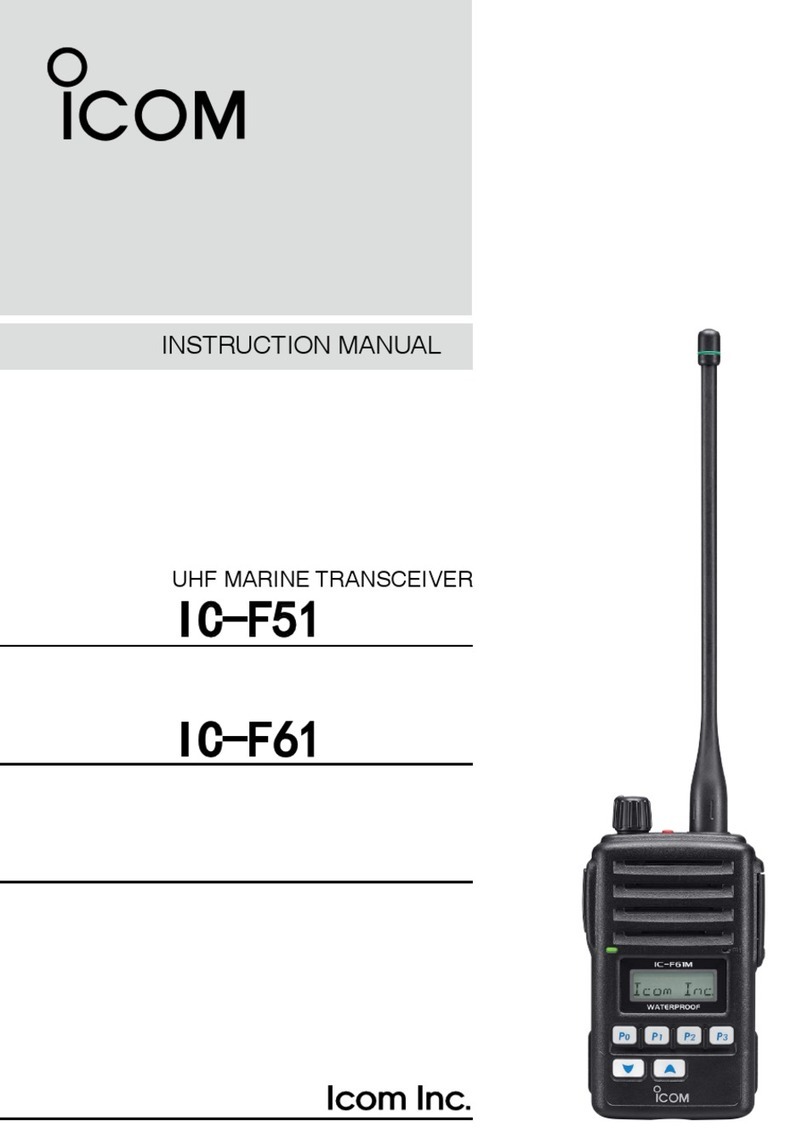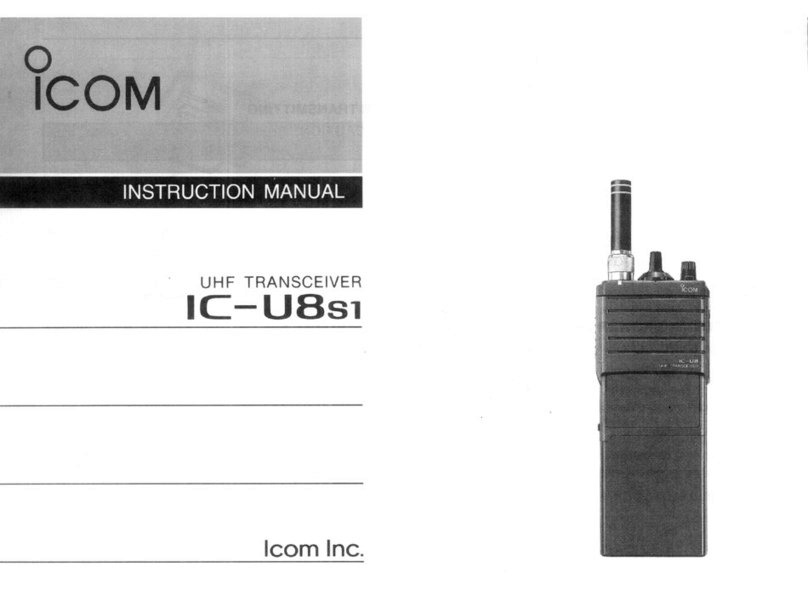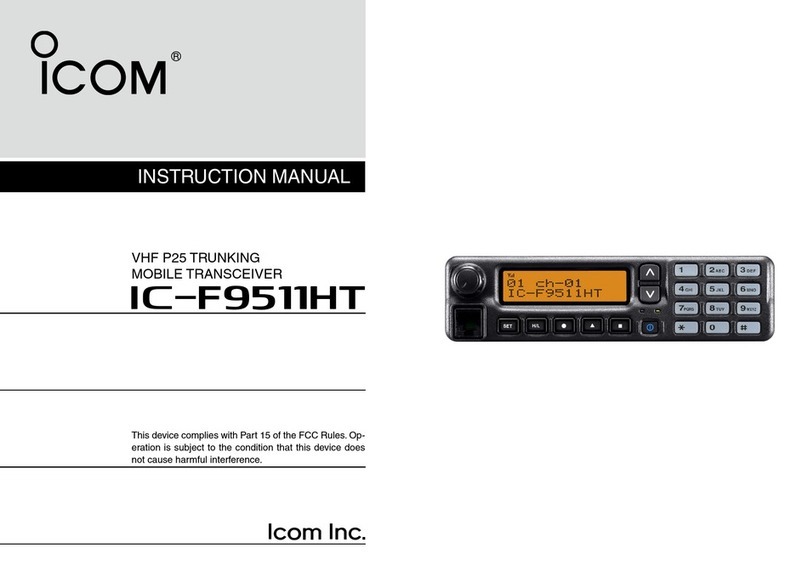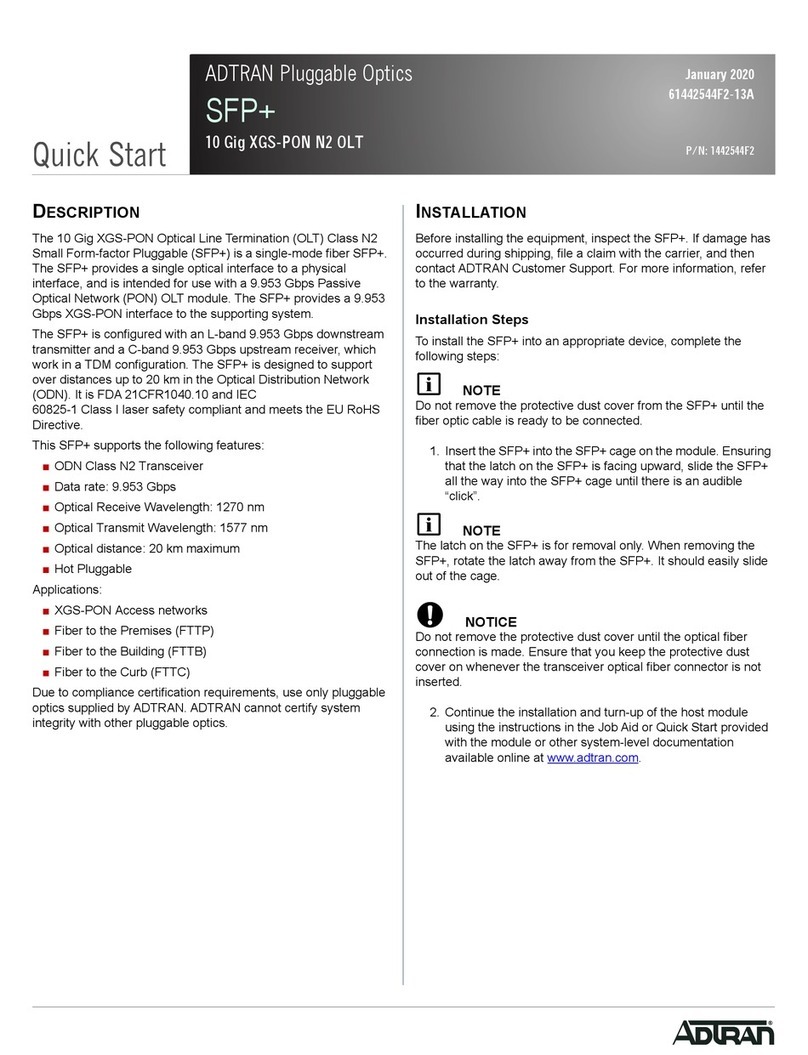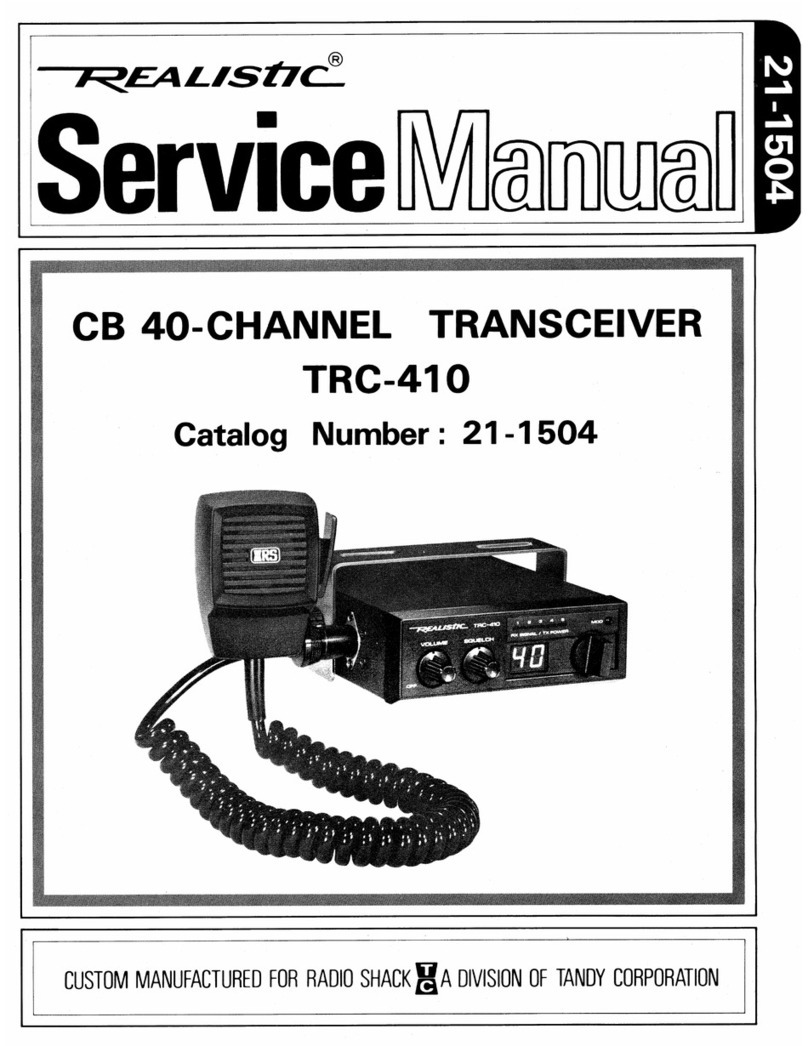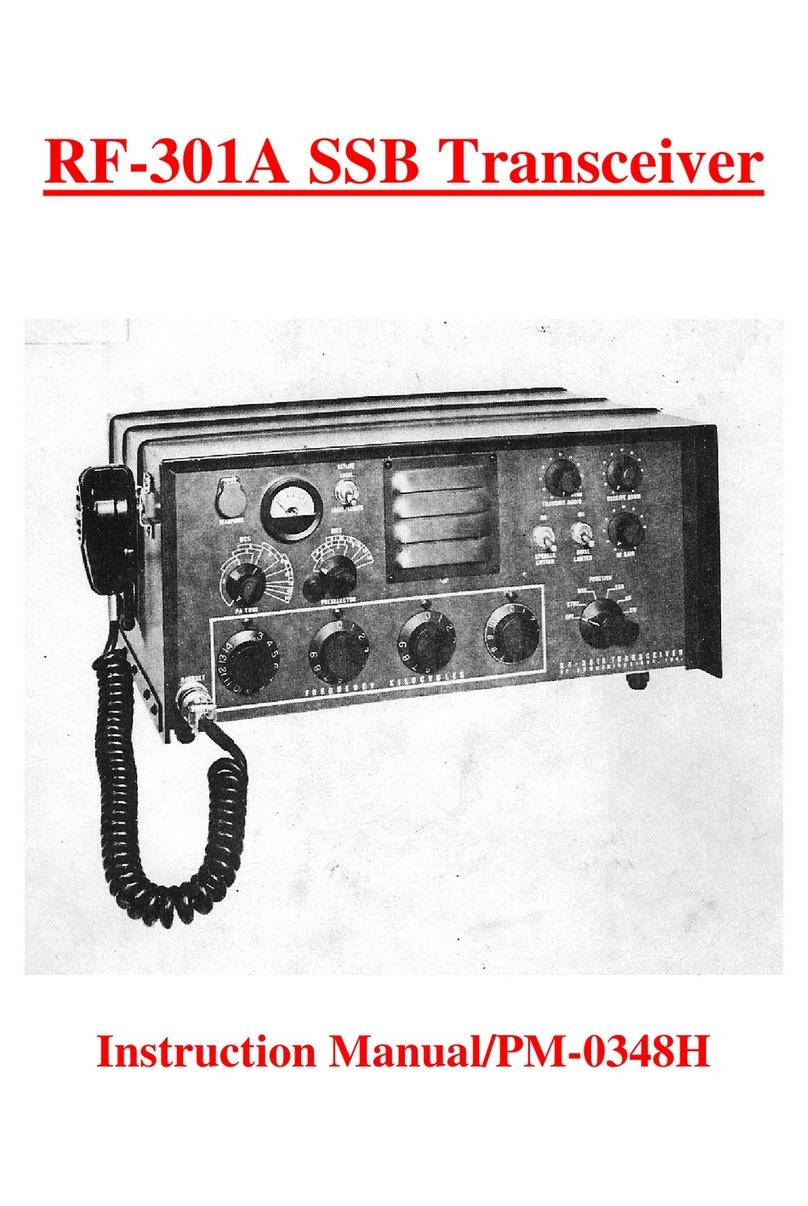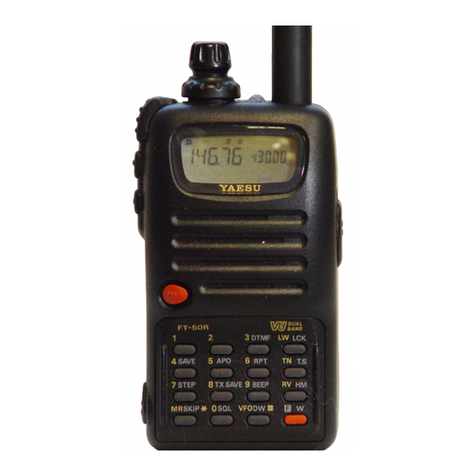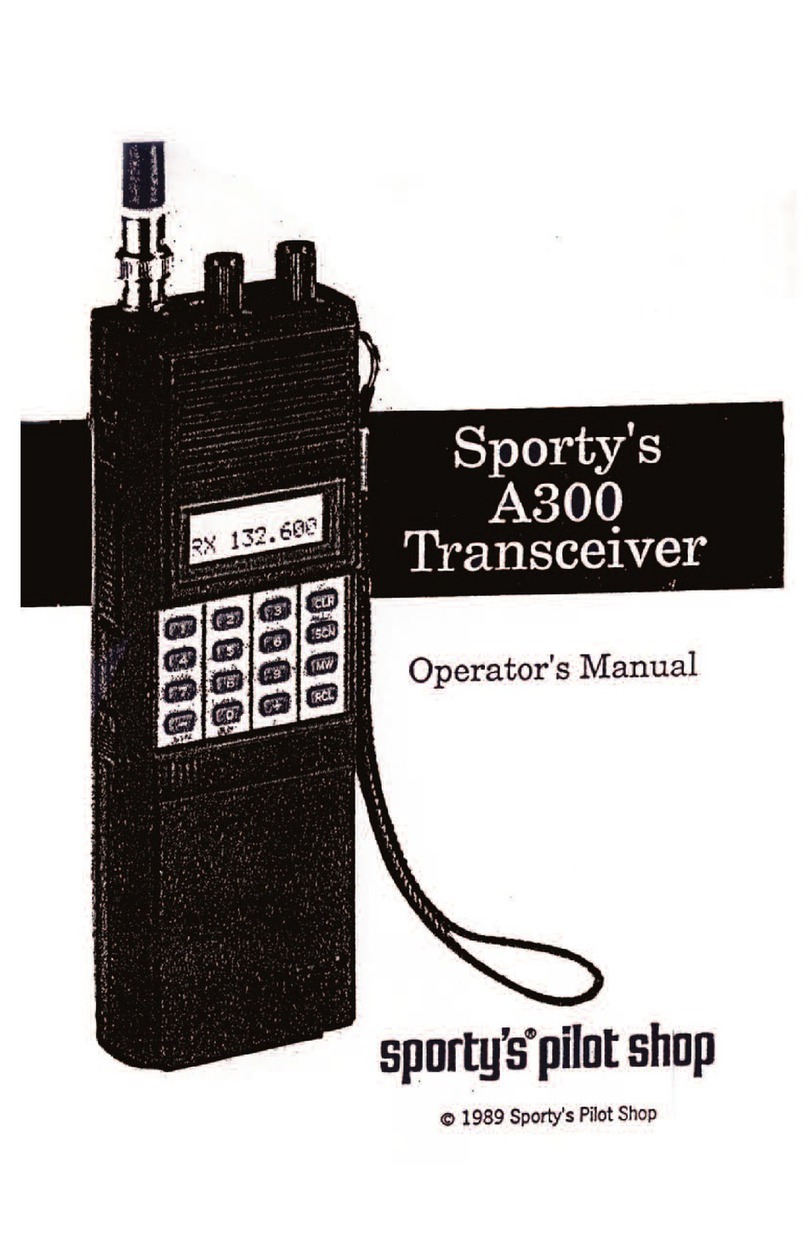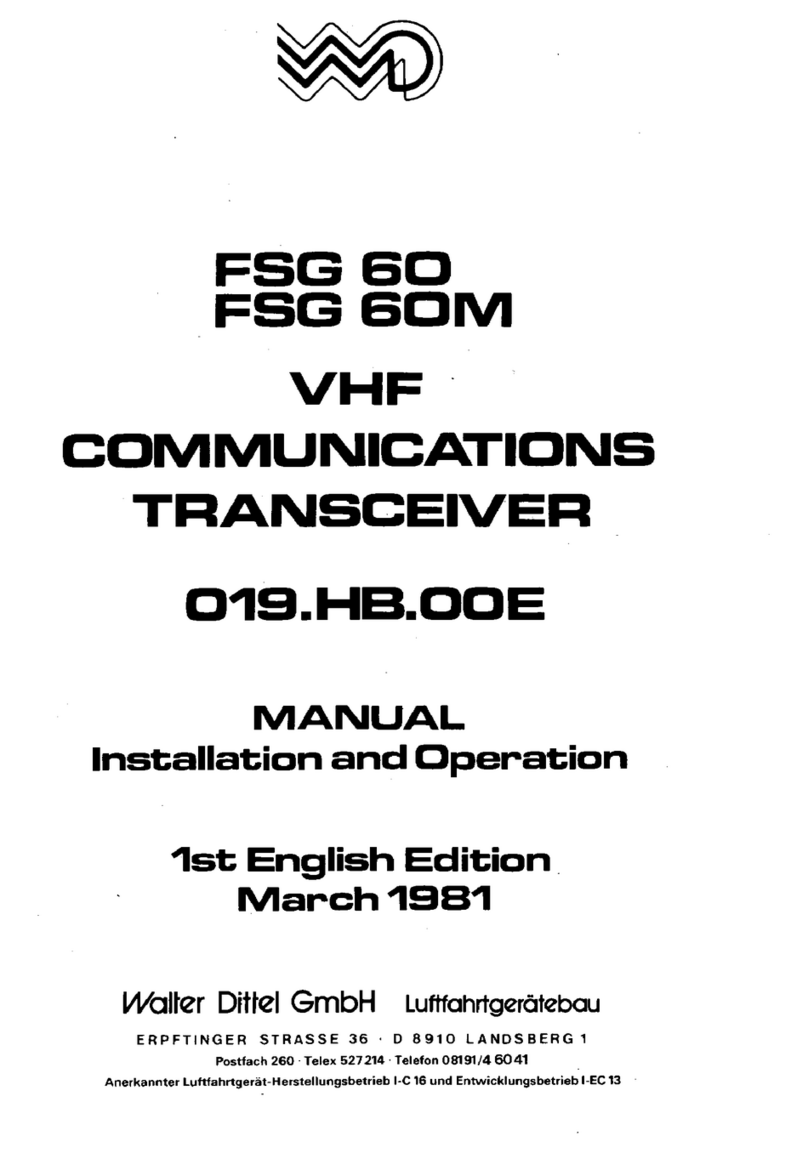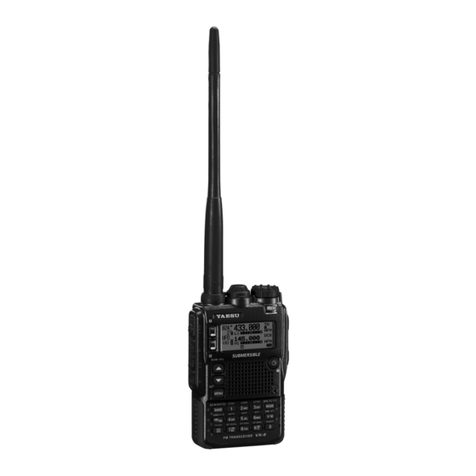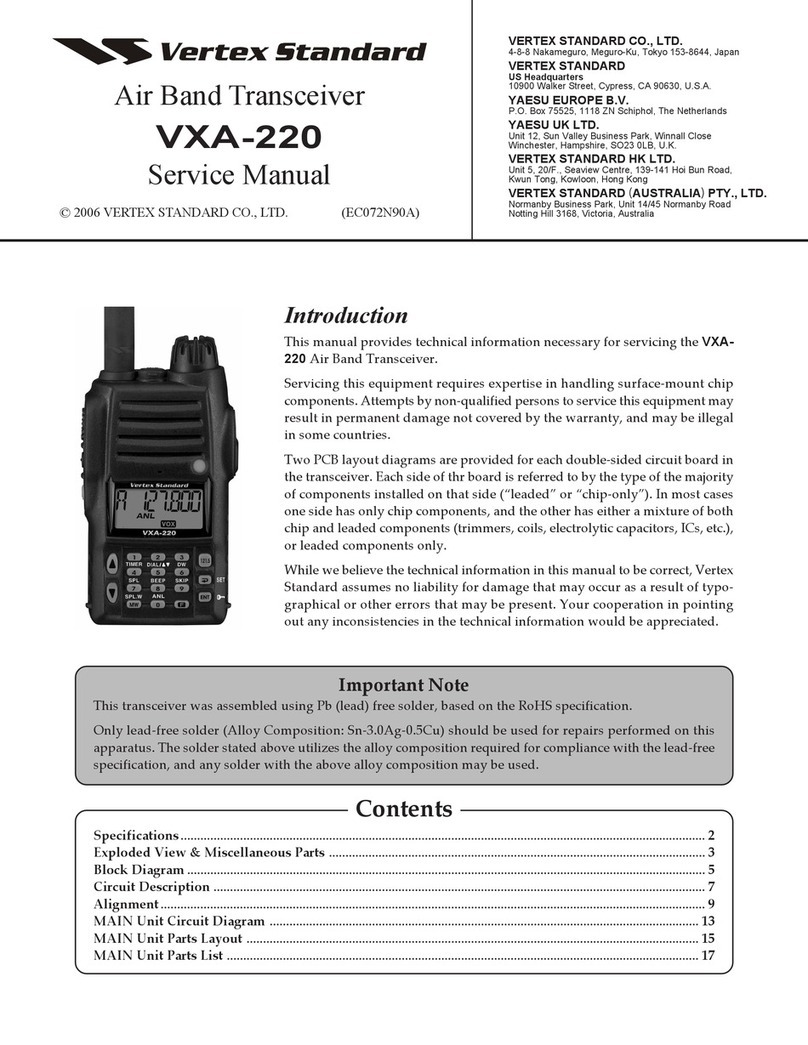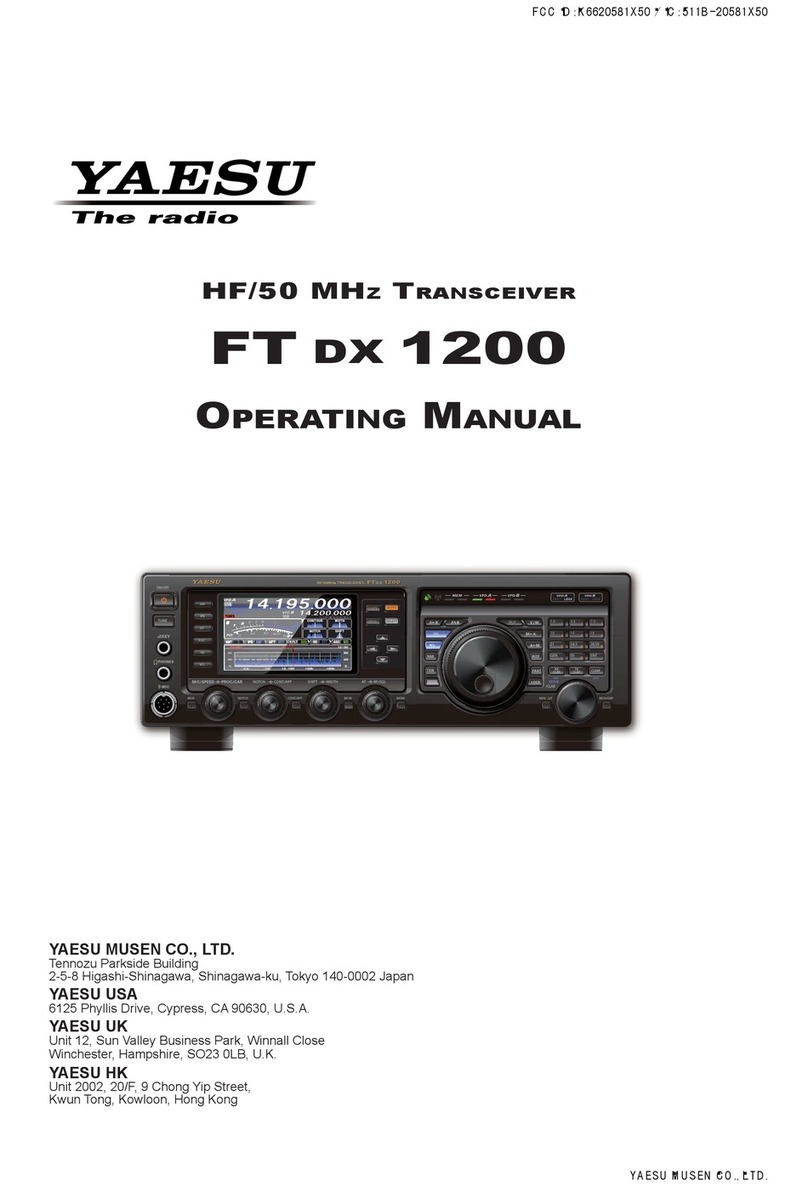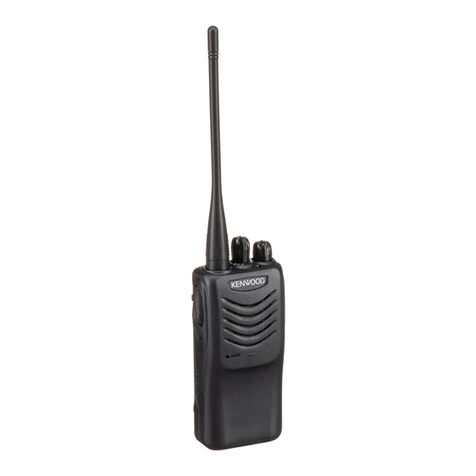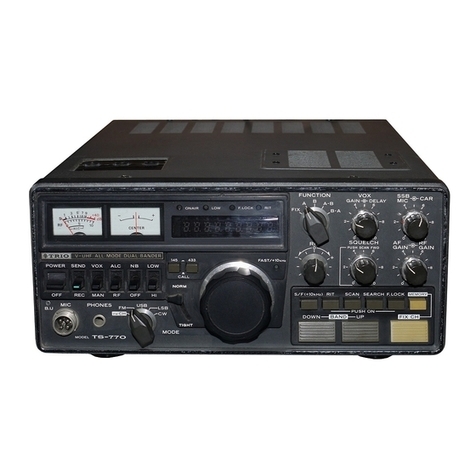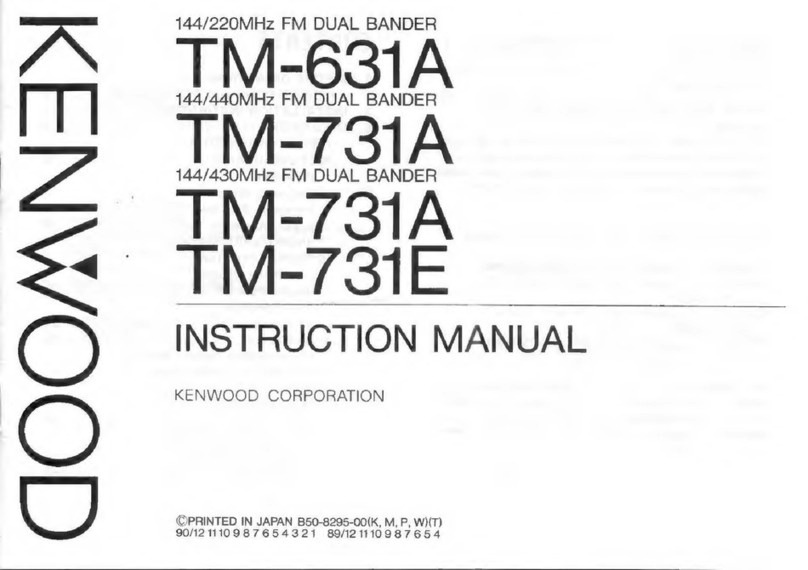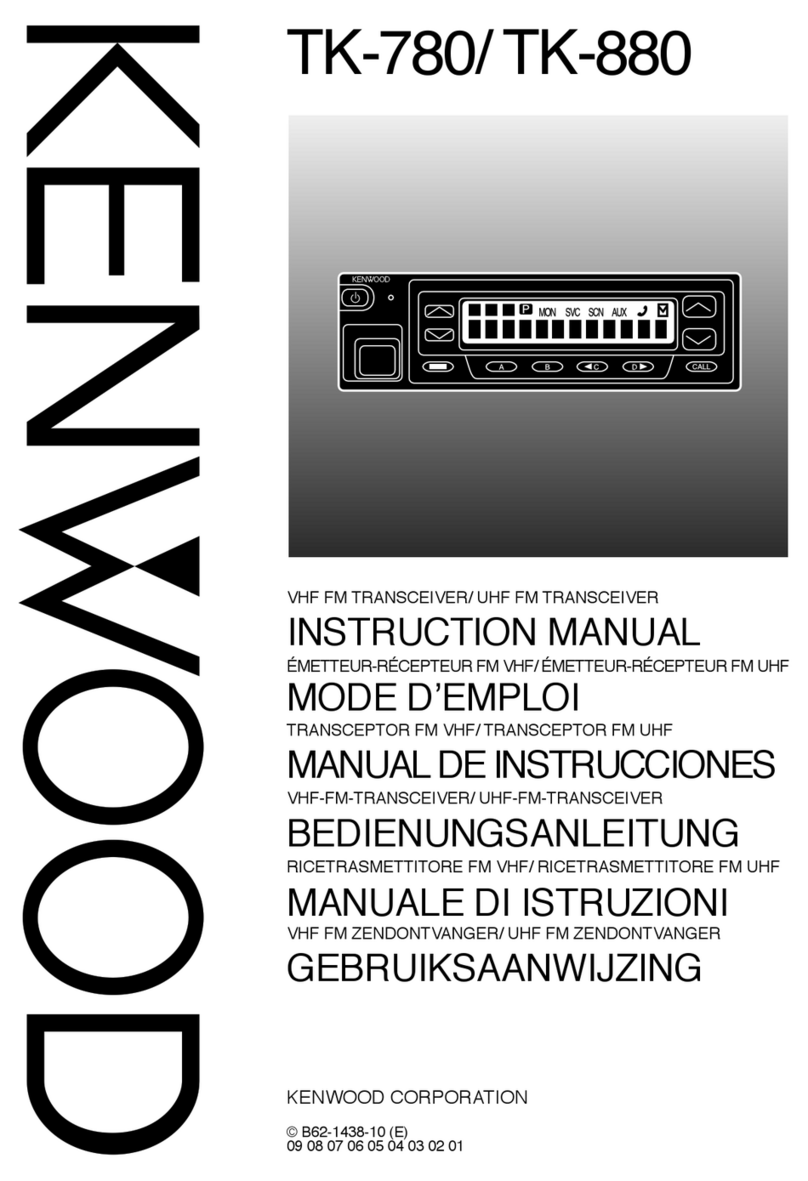Icom i2730A User manual

INSTRUCTION MANUAL
New2001
i2730A
DUAL BAND TRANSCEIVER
i2730E

i
New2001New2001
FOREWORD
Thank you for choosing this fine Icom product. The IC-2730A
and IC-2730E d u a l b a n d t r a n s c e i v e r are designed and
build with Icom’s superior technology and craftsmanship
combining traditional analog technologies.
With proper care, this product should provide you with years
of trouble-free operation.
We hope you agree with Icom’s philosophy of “technology
first.” Many hours or research and development went into the
design of your IC-2730A or IC-2730E.
EXPLICIT DEFINITIONS
WORD DEFINITION
RDANGER! Personal death, serious injury or an ex-
plosion may occur.
RWARNING! Personal injury, fire hazard or electric
shock may occur.
CAUTION Equipment damage may occur.
NOTE Recommended for optimum use. No risk
of personal injury, fire or electric shock.
IMPORTANT
READ ALL INSTRUCTIONS carefully and completely
before using the transceiver.
SAVE THIS INSTRUCTION MANUAL— This in-
struction manual contains basic operating instructions for the
IC-2730A or IC-2730E.
SUPPLIED ACCESSORIES
The following accessories are supplied with the transceiver.
DC power
cable
Controller cable
(3.5 m:11.4 ft)
Microphone
(HM-207)
Spare fuse
(FGB 15 A)
Microphone
hanger
For European version:
Installing in a vehicle is inhibited for the European countries’
transceiver.

New2001New2001
ii
RDANGER HIGH VOLTAGE! NEVER touch an antenna
connector during transmission. This may result in an electrical
shock or burn.
RWARNING RF EXPOSURE! This transceiver emits Ra-
dio Frequency (RF) energy. Extreme caution should be observed
when operating this transceiver. If you have any questions re-
garding RF exposure and safety standards please refer to the
Federal Communications Commission Office of Engineering and
Technology’s report on Evaluating Compliance with FCC Guide-
lines for Human Radio Frequency Electromagnetic Fields (OET
Bulletin 65).
RWARNING! NEVER operate the transceiver while driving
a vehicle. Safe driving requires your full attention—anything less
may result in an accident.
RWARNING! NEVER operate the transceiver with an ear-
phone or other audio accessories at high volume levels. Continu-
ous high volume operation may cause a ringing in your ears. If you
experience ringing, reduce the volume level or discontinue use.
RWARNING! NEVER connect the transceiver to an AC out-
let. This may pose a fire hazard or result in an electric shock.
RWARNING! NEVER connect the transceiver to a power
source of more than 16 V DC such as a 24 V DC. This could
cause a fire or damage the transceiver.
RWARNING! NEVER reverse the DC power cable polar-
ity when connecting to a power source. This could damage the
transceiver.
RWARNING! NEVER cut the DC power cable between the
DC plug and fuse holder. If an incorrect connection is made after
cutting, the transceiver may be damaged.
RWARNING! NEVER let metal, wire or other objects touch
any internal part or connectors on the rear panel of the trans-
ceiver. This may result in an electric shock or this could cause a
fire or damage the transceiver.
RWARNING! NEVER operate or touch the transceiver with
wet hands. This may result in an electric shock or may damage
the transceiver.
RWARNING! Immediately turn OFF the transceiver power
and remove the power cable if it emits an abnormal odor, sound
or smoke. Contact your Icom dealer or distributor for advice.
CAUTION: NEVER expose the transceiver to rain, snow or
any liquids.
CAUTION: NEVER change the internal settings of the trans-
ceiver. This may reduce transceiver performance and/or damage
to the transceiver.
CAUTION: NEVER place the transceiver where normal op-
eration of the vehicle may be hindered or where it could cause
bodily injury.
DO NOT operate the transceiver near unshielded electrical
blasting caps or in an explosive atmosphere.
DO NOT push the PTT when not actually desiring to transmit.
PRECAUTIONS

iii
New2001 New2001
DO NOT use harsh solvents such as benzine or alcohol to clean
the transceiver, as they will damage the transceiver’s surfaces. If
the transceiver becomes dusty or dirty, wipe it clean with a soft,
dry cloth.
DO NOT use or place the transceiver in areas with tempera-
tures below –10°C (+14°F) or above +60°C (+140°F). Be aware
that temperatures on a vehicle’s dashboard can exceed +80°C
(+176°F) in direct sunlight, resulting in permanent damage to the
transceiver if left there for extended periods.
DO NOT place the transceiver in excessively dusty environ-
ments or in direct sunlight.
DO NOT place the transceiver against walls or putting anything on
top of the transceiver. This will obstruct heat dissipation.
Place the transceiver in a secure place to avoid inadvertent use
by children.
During mobile operation, NEVER place the transceiver where
air bag deployment may be obstructed.
During mobile operation, DO NOT place the transceiver where
hot or cold air blows directly onto it.
During mobile operation, DO NOT operate the transceiver with-
out running the vehicle’s engine. When the transceiver’s power
is ON and your vehicle’s engine is OFF, the vehicle’s battery will
soon become exhausted.
Make sure the transceiver power is OFF before starting the ve-
hicle engine. This will avoid possible damage to the transceiver
by ignition voltage spikes.
During maritime mobile operation, keep the transceiver and mi-
crophone as far away as possible from the magnetic navigation
compass to prevent erroneous indications.
BE CAREFUL! The rear panel will become hot when operat-
ing the transceiver continuously for long periods of time.
Use Icom microphones only (supplied or optional). Other manu-
facturer’s microphones have different pin assignments, and may
damage the transceiver.
PRECAUTIONS (Continued)
Icom, Icom Inc. and the Icom logo are registered trademarks of Icom
Incorporated (Japan) in Japan, the United States, the United King-
dom, Germany, France, Spain, Russia, and/or other countries.
The Bluetooth word mark and logos are registered trademarks
owned by Bluetooth SIG, Inc. and any use of such marks by Icom
inc. is under license.
All other products or brands are registered trademarks or trademarks
of their respective holders.

New2001
iv
TABLE OF CONTENTS
FOREWORD ...................................................i
EXPLICIT DEFINITIONS.................................i
IMPORTANT....................................................i
SUPPLIED ACCESSORIES............................i
PRECAUTIONS..............................................ii
TABLE OF CONTENTS.................................iv
1 PANEL DESCRIPTION........................... 1
Controller — Front panel■.................... 1
Controller — Display■........................... 2
Main unit■............................................. 5
About the HM-207 microphone■.......... 6
2 MENU MODE.......................................... 9
MENU mode screen■........................... 9
MENU mode construction■.................. 9
Selecting the MENU item■................. 11
Setting items■..................................... 12
MENU items■..................................... 18
3 BASIC OPERATION............................. 23
Selecting the MAIN band■.................. 23
Selecting the Mode■........................... 23
Selecting the operating band■............ 24
Setting a frequency■.......................... 24
■
Setting audio volume and squelch level
. 25
Lock function■.................................... 25
Transmitting■...................................... 26
Selecting the operating mode■........... 26
Audio mute function■.......................... 27
Monitor function■................................ 27
Setting the microphone gain level■.... 27
4 MEMORY OPERATION........................ 28
General description■.......................... 28
Selecting a Memory or Call channel■. 29
Writing into a Memory or Call channel■
.. 30
Setting a Memory bank■.................... 32
Entering a Memory or Bank name■... 34
Clearing a Memory channel■............. 35
5 SCAN OPERATION.............................. 36
About the scan function■.................... 36
Entering scan edges■......................... 38
VFO mode scan■............................... 41
Setting and clearing the skip frequencies■
. . 42
Memory scan■.................................... 43
Setting and clearing skip channels■... 44
Setting the temporary skip function■. . 44
6 PRIORITY WATCH ............................... 45
Priority watch■.................................... 45
VFO and a Priority channel■.............. 46
VFO and a Memory/Bank scan■........ 47
7
REPEATER AND DUPLEX OPERATIONS
. 48
Repeater operation■........................... 48
Duplex operation■.............................. 50
Off band indication■........................... 51
Auto repeater function■...................... 52
8 OTHER FUNCTIONS............................ 53
Home■Channel Beep function .......... 53
Using the DTMF Memory■................. 54
Transmitting DTMF code■.................. 55
Tone Squelch function■...................... 56
Weather channel operation■.............. 60
Cloning function■................................ 61
Connecting the controller to the main unit■
. . 63
Connecting a microphone■................ 63
9
INSTALLATION AND CONNECTIONS
. 63
Connecting to a DC power supply■.... 64
Installing the controller■..................... 64
Installing in a vehicle■........................ 66
Installing an antenna■........................ 67
Connecting to a battery■.................... 68
10 OPTIONS.............................................. 70
11 Bluetooth®OPERATION ..................... 71
Operating Bluetooth■®........................ 71
Electromagnetic Interference■............ 71
Installing the UT-133■......................... 72
Pairing with a headset■...................... 73
VOX function■..................................... 74
Other headset settings■.................... 75
■
The maximum number of paired devices
. 77
■
Disconnecting from a Bluetooth
®
device
. 77
Deleting a Bluetooth■®device
from the pairing list ........................... 77
■
Resetting the installed Bluetooth®unit
. 78
12 SPECIFICATIONS ................................ 79
Resetting■.......................................... 81
13 MAINTENANCE ................................... 81
Power protect function■...................... 82
Spurious signals■............................... 82
Fuse replacement■............................. 82
Troubleshooting■................................ 83
14 INFORMATION ..................................... 85
COUNTRY CODE LIST ........................ 85
FCC INFORMATION............................. 85
INDEX.......................................................... 85

New2001
1
New2001New2001
PANEL DESCRIPTION
1
e
r
t
yuiuy
q
w
e
r
t
w
■Controller — Front panel
qPOWER KEY [ ]( )
Hold down for 1 second to turn power ON or OFF.➥
Push to mute the audio. (p. 27)➥
wMAIN•BANDKEY[MAINBAND]
Push to select the MAIN band. (p. 23)
In the VFO mode
Hold down for 1 second to enter the Operating band select
mode. (p. 24)
In the Memory mode
Hold down for 1 second to enter the Memory bank select
mode. (p. 33)
eVFO/MHzTUNING•SCANKEY[V/MHzSCAN]
Push to select the VFO mode.➥
In the VFO mode, push to select 1 MHz tuning. (p. 24)➥
Hold down for 1 second to display the scan type setting➥
screen. (pp. 41, 43)
rMEMORY•CALLKEY[MRCALL]
In the VFO mode, push to select the Memory mode.➥
(p. 23)
In the Memory mode, push to select the Weather chan-➥
nel mode.* (p. 23)
*Weather channels are selectable in only the USA version.
Hold down for 1 second to select the Call channel➥
mode. (p. 23)
tVOLUME CONTROL (p. 23)
yTUNING DIAL [DIAL]
In the VFO mode
Rotate to select the operating frequency. (pp. 24, 25)
In the Memory mode
Rotate to select a Memory channel. (p. 29)
While scanning
Rotate to change the scanning direction. (p. 37)
In the MENU mode
Rotate to select a desired option or value. (p. 11)
uSQUELCH CONTROL (p. 25)
Rotate to adjust the squelch level.
Display (p. 2)
Microphone
connector (pp. 5, 63)
For your reference:
The key-touch beep tones on the left band are different than
the tones on the right band. The different tones will let you
know which band you are operating on.
o !0 !1

2
1
PANEL DESCRIPTION
New2001
1
PANEL DESCRIPTION
New2001
iMONITOR•DUPLEXKEY[DUPMONI]
Push to turn the Monitor function ON and OFF. (p. 27)➥
Hold down for 1 second to display the duplex direction➥
setting screen. (p. 50)
oOUTPUTPOWER•DTMFKEY[LOWDTMF]
Push to➥select the transmit output power level. (p. 26)
Hold down for 1 second to enter the DTMF Menu mode.➥
(p. 54)
!0 MEMORY WRITE KEY [MW]
In the VFO mode
Push to display the Memory write screen. (p. 30)➥
Hold down for 1 second to store the operating frequen-➥
cy into a blank Memory channel. (p. 30)
In the Memory mode
Push to display the Memory entry screen. (p. 31)➥
!1 MENU LOCK KEY [MENU ]
Push to enter the MENU mode.➥
Hold down for 1 second to turn the Lock function ON➥
or OFF.
■Controller — Display
qMAIN ICON
Displayed on the MAIN band. (p. 23)
•YoucantransmitononlytheMAINband.
•TheMENUmodesettingsarefortheMAINband.
wTX ICON (p. 26)
Displayed while transmitting.
eDUPLEX ICON (p. 50)
Displayed while in the duplex mode.
rTONE ICONS (p. 56)
tBluetooth®ICON (p. 74)
Displayed when you make a Bluetooth®connection be-
tween your transceiver* and a Bluetooth®headset.
*Requires an optional UT-133 Bluetooth®u n i t installed.
yKEY LOCK ICON (p. 25)
Displayed when the Lock function is ON.
uFREQUENCY READOUT (pp. 9, 24)
Displays the operating frequency, MENU item, and so on.
q w e r t y
u

3
1PANEL DESCRIPTION
New2001 New2001
New2001
iMEMORY CHANNEL NUMBER (p. 29)
Displays the selected Memory channel, Memory Bank,
Call channel, or Menu item.
oPRIORITY ICON (p. 46)
Displayed when Priority Watch is turned ON.
!0 SKIP ICON (p. 42)
Appears when the displayed Memory channel is specified
as a skip channel.
!1 MODE ICON (p. 26)
Displays the operating mode.
!2 POWER ICON (p. 26)
Displays the output power level.
•“LOW”isdisplayedwhenyouselectlowpower.
•“MID”isdisplayedwhenyouselectmidpower.
•Noiconisdisplayedwhenyouselecthighpower.
!3 VOX ICON (p. 75)
Displayed when the transceiver is connected to the optional
VS-3 Bluetooth®h e a d s e t , and the VOX function is ON.
!4 MEMORY MODE ICON (p. 29)
Displayed while in the Memory mode.
!5 S/RF METER
Displays the relative signal strength of the receive signal.➥
Displays the output power level of the transmit signal.➥
(p. 26)
!6 BUSY ICON
Displayed while a signal is being received, or the➥
squelch is open.
Blinks while the Monitor function is activated. (p. 27)➥
The following key icons are displayed in the MENU mode
or Memory write screen, and you can push a key that is
located below the icon.
!7 CLEAR KEY [CLR]
In the MENU mode
Push to return to the previous screen. (p. 9)
While entering text
Push to delete the selected character or number.➥
(p. 34)
Hold down for 1 second to delete the selected charac-➥
ter or number, and all characters that are located to the
right of the cursor. (p. 54)
Controller — Display (Continued)■
o
!0
!1!3!4!5
!6
!2
!7!8!9
i

New2001
4
1
PANEL DESCRIPTION
New2001
1
PANEL DESCRIPTION
!8 ENTER KEY [ï]
Push to go to the next tree level or to set the option or
value in the MENU mode. (pp. 11, 30)
!9 LEFT/RIGHT KEYS [Ω]/[≈]
In the MENU mode (p. 11)
[Ω]: Push to go back the previous tree level.
[≈]: Push to go to the next tree level.
While entering text (p. 34)
[Ω]: Push to move the cursor left.
[≈]: Push to move the cursor right.

5
1PANEL DESCRIPTION
New2001 New2001
New2001
■Main unit
qCONTROLLER CONNECTOR [CONTROLLER] (p. 63)
Connects to the Controller using the supplied control cable.
wMICROPHONE CONNECTOR [MIC]
Plug in the supplied HM-207 microphone or the optional
HM-154 microphone.
eANTENNA CONNECTOR (p. 67)
Connect a 50 øimpedance antenna with a PL-259 con-
nector.
The transceiver has a built-in duplexer, so you can use a
144 and 430 MHz dual-band antenna without needing an
external duplexer.
rCOOLING FAN
The cooling fan for heat dissipation.
You can select the Fan control option in EXMENU, to au-
tomatically start rotating when you begin transmitting, or
continuously rotate from power ON. (p. 14)
tDC POWER SOCKET [DC 13.8V]
Connect a 13.8 V DC power source through the supplied
DC power cable.
yEXTERNAL SPEAKER JACK 2 [SP2]
uEXTERNAL SPEAKER JACK 1 [SP1]
Connect an 8 ohm external speaker.
•Seethefollowinglistforthespeakerconnectionandaudioout-
put details.
Ext. speaker
connection
status
Audio output
External speaker Internal speaker
SP-1 SP-2
SP-1 and SP-2 Left band Right band –
SP-1 only Both bands – –
SP-2 only –Right band Left band
DMicrophone connector information
12345678
Front panel
view
1 8 V +8 V DC output
Maximum 10 mA
2 MIC U/D Frequency Up/Down
UP: Ground
DN: Ground through 470 ˘
3 M8V SW HM-207 connection
Grounds when the HM-207 is connected.
4 PTT PTT input
Ground for transmission
5 MIC E Microphone ground
6 MIC Microphone input
7 GND PTT ground
8 DATA IN
Inputs HM-207 data when the HM-207
is connected.
q w e r
t
yu
Front panel Rear panel

New2001
6
1
PANEL DESCRIPTION
New2001
1
PANEL DESCRIPTION
With the HM-207, you can input numbers for frequency or
Memory channel settings, and adjust the audio volume and
squelch level.
q
w
e
!0
t
y
i
u
o
r
Mic element
qLED 1
Lights red while transmitting by pushing [PTT].
w[∫]/[√] (UP/DOWN) KEYS
Push to change the operating frequency or Memory➥
channel.
Hold down to continuously change the frequency or➥
Memory channel.
e[PTT] SWITCH
Hold down to transmit, release to receive.
r[VFO/MR ] KEY
Push to toggle between the VFO and Memory modes.➥
Hold down for 1 second to turn the Lock function ON➥
or OFF. (p. 25)
t[HOME CALL] KEY
Push to select the Home channel.➥
Hold down for 1 second to turn the Call channel mode➥
ON or OFF.
y[MAIN DUAL] KEY
Push to set the MAIN band to either the right band or the
left band.
u[F-1] KEY
Push to activate the preset function of the [F-1] key.
(Default: During RX/Standby: [BND.BNK]
During TX: [T-CALL])
[F-2] KEY
Push to activate the preset function of the [F-2] key.
(Default: During RX/Standby: [MONI],
During TX: [---])
You can assign a desired function in the MENU mode.
(p. 14) See page 8 for details of the key functions.
i[CLR] KEY
In the MENU mode, push to exit the MENU mode.
o[ENT] KEY
After entering a VFO frequency or Memory channel num-
ber, push to set.
!0 LED 2
Lights green when transceiver’s power is ON.
■About the HM-207 microphone

7
1PANEL DESCRIPTION
New2001 New2001
New2001
!1 [VOL∫A] KEY
Push to increase the audio output level.➥
Push to input DTMF code ‘A.’➥
!2 [VOL√B] KEY
Push to decrease the audio output level.➥
Push to input DTMF code ‘B.’➥
!3 [SQL∫C] KEY
Push to increase the squelch level.➥
Push to input DTMF code ‘C.’➥
!4 [SQL√D] KEY
Push to decrease the squelch level.➥
Push to input DTMF code ‘D.’➥
!5 [# CE] KEY
In the frequency entry screen, push to delete a number.➥
Push to input DTMF code ‘#.’➥
•‘F’standsfor‘#’onthedisplay.
!6 [M.] KEY
Push to input a ‘.’ (decimal point) when entering a fre-➥
quency.
Push to input DTMF code ‘➥M.’
•“E”standsfor“M” on the display.
!7 [0] to [9] KEYS
Push to input a frequency, or DTMF codes ‘0’ through ‘9.’
Setting frequency and Memory channelD
[Example for setting the frequency]
First, push [VFO/MR ] to select the VFO mode.
To enter 435.680 MHz:
Push [4], [3], [5], [6], [8], then [0].➥
To change 435.680 MHz to 435.540 MHz:
Push[•],[5],[4],then[0].➥
To enter 433.000 MHz:
Push [4], [3], [3], then [ENT].➥
[Example for setting the Memory channel]
To select the Memory channel ‘5’:
First, push [VFO/MRq] to select the Memory mode.
Push [5] then [ENT].w
[Example for setting the Call channel]
To select a Call channel:
First, hold down [HOME CALL] for 1 second to select theq
Call channel mode.
When C0 is selected, push [w∫] to select C1.
When C1 is selected, push [√] to select C0.
Microphone (HM-207) (Continued)■
!7
!6
!1
!2
!3
!4
!5

New2001
8
1
PANEL DESCRIPTION
New2001
1
PANEL DESCRIPTION
The following functions can be set to [F-1] and [F-2] to use during receive or in stand-by, or during transmit. (p. 14)
During RX/Standby:
Function Description
--- No function
MONI
([F2] key: Default)
Push to open or close the squelch.
MR000 In the Memory mode, push to select Memo-
ry channel 000.
MR001 In the Memory mode, push to select Memo-
ry channel 001.
BND.BNK
([F1] key: Default)
In the VFO mode, push to select an operat-
ing band.
In the Memory mode, push to select Bank
A to J, or OFF.
•Onlytheprogrammedbankappears.
SCAN Push to start or stop a scan.
T-SKIP
Push to set the frequency to be skipped dur-
ing scanning.
The selected frequencies are temporarily
skipped for faster scanning.
MODE Push to change the operating mode.
LOW Push to change the transmit power level.
DUP Push to turn the Duplex mode ON or OFF,
and the shift direction to DUP+ or DUP–.
PRIO
Push to turn the Priority watch ON or OFF.
TONE Push to toggle between tone types.
Function Description
MW
In the VFO mode, hold down for 1 second
to save the frequency displayed in the MAIN
band into a Memory channel.
•Thefrequencyisautomaticallysavedinablank
channel.
MUTE Push to turn the Mute function ON or OFF.
DTMFTX Push to display the DTMF code direct entry
mode screen.
T-CALL Push to transmit a 1750 Hz tone.
During TX:
Function Description
---
([F2] key: Default)
No function
LOW Push to change the transmit power level.
T-CALL
([F1] key: Default)
Push to transmit a 1750 Hz tone.

New2001
9
New2001New2001
MENU MODE
2
The MENU mode is used to program infrequently changed
values or function settings.
•TheMENUmodeitemsarefortheMAINband.
■MENU mode screen
The MENU item is displayed on the left side.
The item’s option or value is displayed on the right side.
MENU item Option or
Value
■MENU mode construction
The MENU mode is constructed in a tree structure.
You can go to the next tree level, or go back a level by pushing
[CLR]D, [ï]D, [Ω]Dor [≈]D. (p. 11)
Side Side
Display
Center
The C, S, or Din the
instructions indicate the
area of the controller.
C: Center
S: Side
D: Display
EXMENU
MOD.TS
MODE
TS 5.0~50.0/AUTO
FM/FM-N/AM/AM-N
DUP.T
TONE
0.000~59.995
67.0~254.1
67.0~254.1
023~754
BOTH N/TN-RR/TR-RN/BOTH R
OFFSET
R TONE
C TONE
TBURST
CODE
DTCS-P
OFF/ON
SCAN
PRIO
PAUSE
RESUME
TEMP
P-SKIP
B-LINK
P-EDGE
P-LINK PLINK0~9LINK/NAME/ADD/CLEAR
PROG00~24 NAME/FREQ L/FREQ H/
TS/MODE/WRITE
BANK-A~J
5MIN/10MIN/15MIN
0SEC/1~5SEC/HOLD
2~20SEC/HOLD
OFF/ON/BELL
OFF/ON
OFF/ON
OFF/TONE/TSQL /TSQL/DTCS /
DTCS/TSQL-R/DTCS-R/DTC.OFF/
TON.DTC/DTC.TSQ/TON.TSQ
WX-ALT OFF/ON
BOTH N/TN-RR/TR-RN/BOTH R
PAUSE
MENU
TONE
0.000~59.995
67.0~254.1
67.0~254.1
023~754
1~4
OFF/ON/BELL
2~20SEC/HOLD
0SEC/1~5SEC/HOLD
FM/FM-N, AM/AM-N
5.0~50.0/AUTO
OFFSET
R TONE
C TONE
CODE
DTCS-P
TS
LIGHT
PRIO
RESUME
MODE
HOMECH
EXMENU EXMENU construction is shown to the right.
SET.FRQ, SET CH/CLEAR
OFF/TONE/TSQL /TSQL/DTCS /DTCS/
TSQL-R/DTCS-R/DTC.OFF/TON.DTC/DTC.
TSQ/TON.TSQ
OFF/ON
WX-ALT

10
2
MENU MODE
New2001
2
MENU MODE
New2001
EXMENU (Continued)
FUNC
SQLTYP OFF/S SQL/ATT
SQL-DL
FAN
DIAL S
AUTORP*
RMTMIC
UDMIC
PTT
PTT LK
LK OUT
TOT
ACTIVE
MIC G
AP OFF OFF/30~120MIN
1~4
SINGLE/ALL/HAM
OFF/1~30MIN
PUSH/HOLD
RX/TX
RX/TX
F-1/F-2
UP/DN
OFF/ON (KOR version)
OFF/DUP/DUP.TON (USA version)
OFF/ON
OFF/ON
OFF/ON
SLOW/MID/FAST/AUTO
SHORT/LONG
CI-V
IF-EXC
CIVADR 01~DF
CIVBAU
CIVTRN OFF/ON
4800~19200/AUTO
OFF/ON
DISP
LIGHT
AT-DIM
DIM TM
CONT
OPN.MSG
NAME
AIR* CH ID/FREQ
1~10
5SEC/10SEC
OFF/AT-OFF/AT-1~3
1~4
OFF/ON
OFF/ON
SOUNDS
BEEPLV
KEY B
HOME B
EDGE B
STOP B
SUBMUT OFF/MUTE/BEEP/MUT.BP
OFF/ON
OFF/ON
0~9
OFF/ON
OFF/ON
HOMECH SET.FRQ SET CH/CLEAR
BT SET
BT
AT CON
CONNEC
/DISCON
PAIR
HS SET
INITBT YES/NO
AF OUT
HSFUNC
VOX
ICOMHS PoSAVE
PTT
PTT B
CUST B
CUST K
PLAY/FWD/RWD
PUSH/HOLD
OFF/ON
OFF/ON
OFF/ON
VOX
VOX LV
VOX.DLY
VOX.TOT OFF/1~15MIN
0.5~3.0
OFF/1~10
NORMAL/MIC/P-AMAN
/P-ACON
HS/HS+SP
OFF/ON
OFF/ON
OFF/ON
OTHERS
INFO
CLONE
RESET PART
ALL
CLONE
MASTER
NO/YES
NO/YES
NO/YES
NO/YES
VOLT/VER
*This item may not be displayed, depending on the transceiver’s version.

11
2MENU MODE
New2001 New2001
New2001
■Selecting the MENU item
In addition to this page, see pages 12 through 22 for details.
For your reference:
The MENU system is constructed in a tree structure. You
can go to the next tree level, or go back a level, depending
on the selected item.
Example: Set the tuning step
Push [MAIN BAND]qSof the band that the tuning step is
set.
•SelectstheMainband.
Push [MENUw]C.
•EnterstheMENUmode.
e Rotate [DIAL]Sto select the “MENU-TS” (Tuning step)
item.
Push [rï]D.
•Goestothenexttreelevel.
•Pushing[≈]Dalso goes to the next tree level.
To return to the default setting:
Hold down [MR CALL] after doing step r.
Rotate [DIAL]tSto select the desired value.
Selectable values:
5 kHz, 6.25 kHz, 8.33 kHz*, 10 kHz, 12.5 kHz, 15 kHz,
20 kHz, 25 kHz, 30 kHz, 50 kHz, or AUTO*.
*Appears only when the AIR band is selected.
Push [yï]D.
•Setstheselectedvalue,andgoesbacktotheprevioustreelevel.
•Pushing[Ω]Dalso goes back to the previous tree level.
Push [MAIN BAND]uS.
•ExitstheMENUmode.
•Pushing[V/MHz SCAN]Sor [MR CALL]Salso exits the MENU
mode.
Side Side
Display
Center
The C, S, or Din the
instructions indicate the
area of the controller.
C: Center
S: Side
D: Display

New2001
12
2
MENU MODE
New2001
2
MENU MODE
■Setting items
DMENU mode
See pages 18 to 22 for details of each MENU mode item’s
options and their default values.
Tone
Sets a channel tone type.
Frequency offset
Sets the frequency offset for duplex (repeater) operation.
Repeater tone
Sets a tone frequency used to access repeaters.
TSQL frequency
Sets a tone frequency for the Tone squelch function used in the FM
mode.
DTCS code
Sets a DTCS (both encoder/decoder) code for DTCS squelch func-
tion used in the FM mode.
DTCS polarity
Sets the DTCS polarity for the DTCS squelch function.
Tuning step
Sets the tuning step to change the frequency in the selected step
when rotating [DIAL]S.
Backlight
Sets the backlight brightness level.
Priority scan
Starts or stops the Priority scan.
Pause timer
Sets the scan pause time. When receiving signals, the scan pauses
according to the scan pause timer.
Resume timer
Sets the scan resume time from a pause after the received signal
disappears.
Weather alert
Sets to sound a beep when a weather alert signal is detected on a
preset weather channel. (Only for the USA version transceiver)
Operating mode
Sets the operating mode.
Home channel
Sets the often-used frequency as the Home channel in the VFO
mode or Memory mode.
EXMENU mode
Push [ï]Dor [≈]Dto enter the EXMENU mode.
DEXMENU mode
See the Icom website for details of the EXMENU mode items.
Mode and Tuning step items
Sets the operating mode and the tuning step.
Operating mode*
Sets the operating mode.
Tuning step*
Sets the tuning step to change the frequency in the selected step
when rotating [DIAL]S.
*You can set in the MENU mode.

13
2MENU MODE
New2001 New2001
New2001
DUP/TONE items
Settings to access repeaters.
Tone*
Sets a channel tone type.
Frequency offset*
Sets the frequency offset for duplex (repeater) operation.
Repeater tone*
Sets a tone frequency used to access repeaters.
TSQL frequency*
Sets a tone frequency for the Tone squelch function used in the
FM mode.
Tone burst
Turns the Tone Burst function ON or OFF.
This function is used to suppress the squelch tail noise heard from
the called transceiver’s speaker.
DTCS code*
Sets a DTCS (both encoder/decoder) code for DTCS squelch
function used in the FM mode.
DTCS polarity*
Sets the DTCS polarity for the DTCS squelch function.
Scan items
Set scan options.
Priority scan*
Starts the Priority scan.
Pause timer*
Selects the scan pause time. When receiving signals, the scan
pauses according to the scan pause timer.
Resume timer*
Selects the scan resume time from a pause after the received sig-
nal disappears.
Temporary skip timer
Selects the Temporary Skip Time. When the time is set, specified
frequencies are skipped for this period during a scan.
Weather alert*
Sets to sound a beep when a weather alert signal is detected on a
preset weather channel. (Only for the USA version transceiver)
Program skip scan
Turns the Program Skip Scan function ON or OFF for a VFO mode
scan.
Bank link
Selects banks to be scanned during a Bank link scan.
Program scan edge
Sets the frequency ranges for the Program scan.
Program scan edge
Displays 25 Program scans.
Name
Enters a name into each Program scan.
Frequency low
Sets the lower edge frequency for each Program scan.
Setting items■
EXMENU mode (Continued)D
*You can set in the MENU mode.

New2001
14
2
MENU MODE
New2001
2
MENU MODE
Frequency high
Sets the higher edge frequency for each Program scan.
Tuning step
Sets the tuning step for each Program scan.
Operating mode
Sets the operating mode for each Program scan.
Program link
Sets the link function for the Program scan.
Program scan link channels
Displays 10 Program scan link memories.
Link
Displays the Program scans that are linked during the Program
link scan.
Name
Enters a name into each Program scan link memory.
Add
Adds the Program scan that is linked during the Program link
scan.
Clear
Deletes the Program scan that is linked during the Program
link scan.
Function items
Sets various function’s options.
Squelch/ATT select
Sets to use the S-Meter Squelch or the Attenuator function for the
[SQL] control.
Squelch delay
Set the squelch delay to prevent repeated opening and closing of
the squelch when receiving the same signal.
Fan control
Sets the cooling fan control operation.
Dial speed-up
Sets to automatically increase the tuning dial speed when rapidly
rotating [DIAL]S.
Auto repeater
Sets the Auto Repeater function.
This item appears only in the Korean and USA version transceiv-
ers.
Remote MIC key
Selects the key function for [F-1] or [F-2] on the supplied HM-207.
During RX/Standby
Selects the key function to be used while receiving or in the
standby mode.
During TX
Selects the key function to be used while transmitting.
Up/Down MIC key
Selects the key function for [UP] or [DN] on the optional HM-154.
During RX/Standby
Selects the key function to be used while receiving or in the
standby mode.
During TX
Selects the key function to be used while transmitting.
One-Touch PTT
Sets the One-Touch PTT function to toggle between transmission
and reception by pushing [PTT].

15
2MENU MODE
New2001 New2001
New2001
Function items (Continued)
PTT lock
Turns the PTT Lock function ON or OFF.
To prevent accidental transmissions, this function disables [PTT].
Busy lockout
Turns the Busy Lockout function ON or OFF.
This function inhibits transmission while receiving a signal, or
when the squelch is open.
Time-out timer
Sets the Time-out timer to prevent an accidental prolonged trans-
mission.
Active band
Allows continuous frequency selection across all bands by rotat-
ing [DIAL].
MIC gain
Sets the microphone sensitivity to suit your preference.
Auto power OFF
Sets to automatically turn OFF the transceiver after a preset time
period of inactivity.
CI-V
See the Icom website for details of the CI-V command.
CI-V address
Sets the transceiver’s unique CI-V hexadecimal address code.
CI-V baud rate
Sets the CI-V data transfer speed.
CI-V transceive
Turns the CI-V Transceive function ON or OFF.
IF exchange
Sets to exchange the Intermediate Frequency between left and
right bands to avoid interference.
Display items
Sets the Display options.
Backlight*
Sets the backlight brightness level.
Auto dimmer
Sets the Auto dimmer function, and the dimmer level.
Auto dimmer timer
Sets the auto dimmer time period.
LCD contrast
Sets the contrast level of the LCD.
Opening message
Sets whether or not to display “ICOM” and the power source volt-
age at power ON.
Memory name
Sets to display either the operating frequency or the channel name
in the Memory mode.
AIR band display
Sets the AIR band display type between Frequency and ID.
This item may not be displayed, depending on the transceiver’s
version.
Setting items■
EXMENU modeD
*You can set in the MENU mode.
This manual suits for next models
3
Table of contents
Other Icom Transceiver manuals
